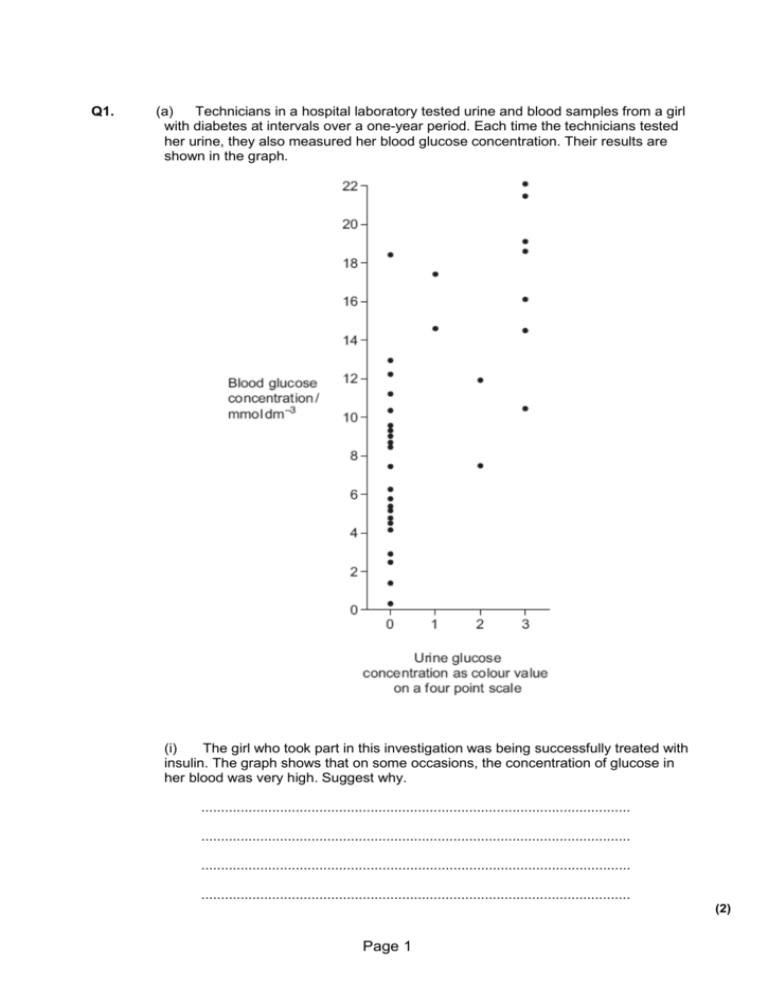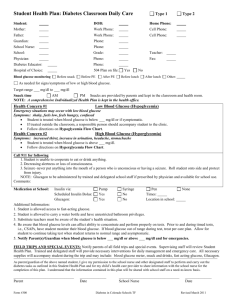Diabetes and blood glucose exam questions and mark scheme
advertisement

Q1. (a) Technicians in a hospital laboratory tested urine and blood samples from a girl with diabetes at intervals over a one-year period. Each time the technicians tested her urine, they also measured her blood glucose concentration. Their results are shown in the graph. (i) The girl who took part in this investigation was being successfully treated with insulin. The graph shows that on some occasions, the concentration of glucose in her blood was very high. Suggest why. ............................................................................................................. ............................................................................................................. ............................................................................................................. ............................................................................................................. (2) Page 1 (ii) Use the graph to evaluate the use of the urine test as a measure of blood glucose concentration. ............................................................................................................. ............................................................................................................. ............................................................................................................. ............................................................................................................. ............................................................................................................. ............................................................................................................. (3) (b) Diabetic people who do not control their blood glucose concentration may become unconscious and go into a coma. A doctor may inject a diabetic person who is in a coma with glucagon. Explain how the glucagon would affect the person’s blood glucose concentration. ...................................................................................................................... ...................................................................................................................... ...................................................................................................................... ...................................................................................................................... (2) (Total 7 marks) Page 2 Q2. A student ate a meal containing carbohydrates at 07:00. He ate nothing else for the next five hours. The table shows the concentration of glucose in his blood at hourly intervals after the meal. Time of day (a) Concentration of glucose in blood/mg per 100 cm3 of blood 07:00 90 08:00 120 09:00 70 10:00 85 11:00 110 12:00 80 Explain the rise in the concentration of glucose between 07:00 and 08:00. ...................................................................................................................... ...................................................................................................................... (1) (b) The concentration of glucose in his blood fell between 08:00 and 09:00. Explain why. ...................................................................................................................... ...................................................................................................................... ...................................................................................................................... ...................................................................................................................... (2) (c) Describe the role of hormones in the fluctuation of glucose concentration between 09:00 and 12:00. ...................................................................................................................... ...................................................................................................................... ...................................................................................................................... ...................................................................................................................... ...................................................................................................................... ...................................................................................................................... ...................................................................................................................... (4) (Total 7 marks) Page 3 Q3. (a) The graph shows changes in the concentration of glucose in a person’s blood following a meal. Changes in the concentration of glucose are controlled by the hormones glucagon and insulin. Write the letters X and Y on the graph to show X a time when glucagon secretion would be high; Y a time when insulin secretion would be high. (1) S (b) Many diabetics require regular injections of insulin. Describe how bacteria can be genetically modified to produce human insulin. ...................................................................................................................... ...................................................................................................................... ...................................................................................................................... ...................................................................................................................... ...................................................................................................................... ...................................................................................................................... ...................................................................................................................... ...................................................................................................................... ...................................................................................................................... ...................................................................................................................... (4) (Total 5 marks) Page 4 Q4. Homeostatic mechanisms maintain a constant environment in the body. (a) The graph shows changes in plasma glucose concentration that occurred in a person who went without food for some time. Use evidence from the graph to explain the role of negative feedback in the control of plasma glucose concentration. ...................................................................................................................... ...................................................................................................................... ...................................................................................................................... ...................................................................................................................... ...................................................................................................................... ...................................................................................................................... ...................................................................................................................... ...................................................................................................................... ...................................................................................................................... ...................................................................................................................... ...................................................................................................................... (5) Page 5 Q5. The diagram shows some of the events which maintain blood glucose concentration in a mammal. (a) Name (i) hormone A; ......................................................................................... (ii) organ B. .............................................................................................. (2) (b) Explain why the events shown in the diagram can be described as an example of negative feedback. ...................................................................................................................... ...................................................................................................................... (1) (Total 3 marks) Page 6 M1. (a) (i) Eaten; Containing carbohydrate/sugar; Glucose absorbed from intestine/into blood; Long time after insulin injection/needs more insulin/has not taken insulin; Does not convert glucose to glycogen/glucose not taken up from blood; 2 max (ii) Shows positive correlation/directly proportional; A range of results for a particular value/values (for different colours) overlap; Urine test only an arbitrary scale/not directly related to concentration/colour is subjective/few colour values; Accept description 3 (b) Glycogen to glucose/glycogenolysis; If name incorrect this disqualifies. By activating enzymes; Gluconeogenesis; Allow explanation in terms of glucose from a noncarbohydrate/named non-carbohydrate source. 2 max [7] M2. (a) Glucose (from digestion of meal) absorbed; Page 7 1 (b) taken up by cells; used in respiration / converted to glycogen; 2 (c) 09:00 to 11:00 glucagon secreted; (Glucagon) stimulates breakdown of glycogen to glucose; 11:00 to 12:00 insulin secreted; Insulin stimulates uptake of glucose by cells / conversion to glycogen; Explanation of negative feedback; Q For the first marking point, answers must refer to glucagon. References to spelling alternatives, such as glycogen, glycogon or glucose should not be awarded credit 4 max [7] M3. (a) On graph: X where glucose level is below norm AND Y where glucose level is above norm; 1 (b) EITHER 1. Use m-RNA + reverse transcriptase to produce gene / (c)-DNA; 2. Restriction enzyme to cut open plasmid; 3. Add sticky ends (to insulin gene and to plasmid); OR Allow: 1. Cut out insulin gene / cut open plasmid with restriction enzyme; 2. Use same restriction enzyme on second DNA; 3. Reference to (complementary) sticky ends; 4. Use ligase to join 2 DNA molecules; 5. Modified plasmid taken up by bacteria; max 4 [5] Page 8 M4. Quality of Communication The answers to all sections of this question require the use of continuous prose. Quality of language should be considered in crediting points in the scheme. In order to gain credit, answers should be expressed logically and unambiguously, using scientific terminology where appropriate. (a) 1. Deviation of a value from norm initiates corrective mechanisms; 2. fluctuations in plasma glucose concentration detected by hypothalmus/ islet cells in pancreas; 3. initial decrease, no food given (in plasma glucose) stimulates (increased) secretion of glucagon; 4. increases (in plasma glucose) stimulate (increased) secretion of insulin; 5. correct ref. to role of and/or β cells as secretors; 6. correct ref. to interconversion of glycogen / glucose; 7. increased/decreased uptake of glucose by cells (as appropriate)/correct ref to change in membrane permeability; max 5 ] M5. (a) (i) glucagon; Insist on spelling 1 (ii) liver; 1 (b) A change to the normal level initiates a response which reduces the effect/reverses/acts against the change; 1 [3] Page 9







